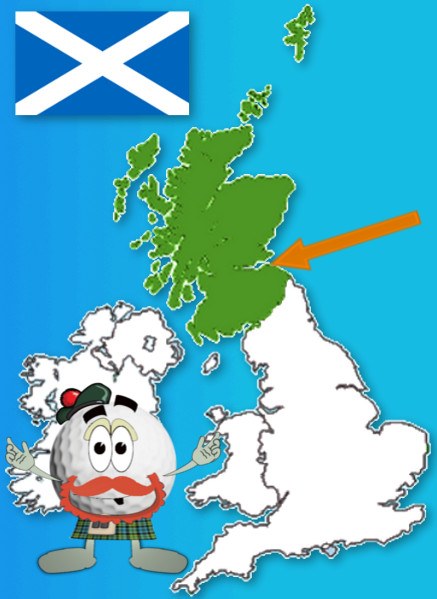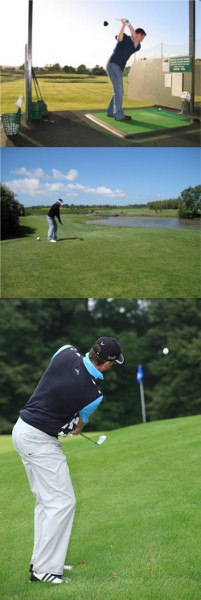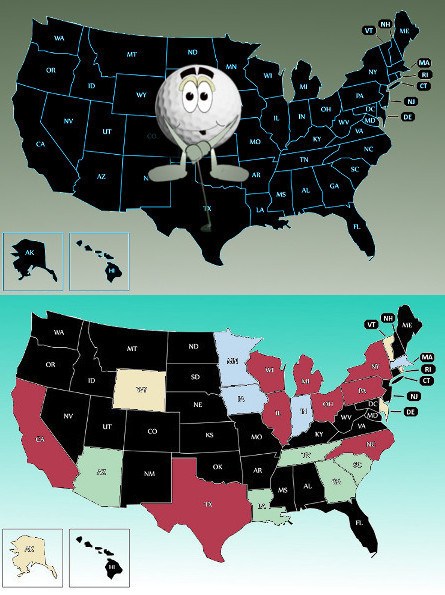There has always been a debate about the origins of golf. It is generally agreed that at least modern golf was developed in Scotland around the Middle Ages. However, not until the 19th century was it popular internationally spreading through the United Kingdom, the British Empire, then the United States.

When James VI of Scotland became king of England in 1603, his son the Prince of Wales and his courtiers played golf at the Blackheath in London. There is evidence that the Scottish soldiers, immigrants, and expatriates brought the game to the British colonies and other areas in the 18th and early 19th centuries. This is what helped the spread of the game of golf to other countries.
The English golfing boom existed from 1880- 1914 and grew at an impressive rate. Starting out with one golf club and increasing to over 1,200. It is estimated that probably over 200,000 golfers used these courses throughout the years. In the beginning golf was only affordable by the elite.
In 1958 the International Golf Federation (IGF) was founded and is recognized as the world’s governing body for golf. The IGF have Federation Members from over 126 countries. They are headquartered in Lake Geneva in Lausanne, Switzerland. They do not develop, maintain, or administer any rules of golf. This federation was set up for the sole purpose of arranging international amateur competitions. The national membership includes the following seven regional associations – Africa Golf Confederation, Americas Golf Association, Arab Golf Federation, Asia-Pacific Golf Confederation, Caribbean Golf Association, European Golf Association, and the South American Golf Federation.
As an Olympic sport, golf was included last in 1904 with the United States and Canada being the only two competing countries. In between most were failed attempts to include golf in the Olympics and was withdrawn. However, with more globalization of the sport, golf will be included in the 2016 and 2020 Olympic Games with the International Olympic Committee’s executive board passing the inclusion by a successful vote.
The Origins of Golf
The Dutch were recorded in 1297 as playing a game using a stick and leather ball. This was known as apocryphally, which is very similar to golf. Some argue that in the 17th century in the Netherlands there was a game of putting a small ball in a hole with the winner being the one that used the fewer strokes, which could precede the game in Scotland.
The earliest mention in Dutch would be around 1261 in which a poet Jacob van Maerlant’s Boeck Merlijn mentions a game of “mit ener coluen” (with a colf/kolf [club]). This ball game was played in the Low Countries. In Brussels around 1360 the council was said to have banned the game of golf. The offending person would pay a fine of 20 schillings or his overcoat would be taken.
The regent of the county of Holland, Zeeland, and Hainaut, Albrecht of Bavaria all sealed a charter for the city of Brielle in 1387. This charter forbids any game to be played for money. The only exception would be to play the ball with a club outside of the town walls. In 1389 the first course or field as it was called then was made due to the fact that playing within the city was too dangerous. This would be considered the first known golf course.
The crew of Willem Barentsz in 1597 was recorded by Gerrit de Veer’s diary as playing “golf” during their stay at the Nova Zembla. The statement was with the weather being so nice for golf, playing golf helped to loosen their limbs. They considered golf to be a great way to exercise.
Scottish Golf Claims
The Scottish make claim to the game of golf in the modern version that is known today. The word golf in Scottish term gowf is thought to be an alteration of the Dutch word colf, which means stick or club. The first documented mention of golf appears in a 1457 Act of the Scottish Parliament. This was an edict issued by King James II of Scotland prohibiting the playing of gowf and football. The king’s reasoning was that this was a distraction for his military’s archery practices. In additional Act in 1471 and 1491 these bans were imposed again stating that golf was “an unprofitable sport”.
After the murder of her second husband in 1567, Mary the queen of Scots was attacked by her political enemies accusing her of playing sports that was clearly unsuitable for women. So, golf was again banned by the parliament now under King James IV. In 1592 when the king would visit Perth, St. Andrews, and Edinburgh, however golf clubs and balls were brought to him to enjoy a game or two. Such rules were added by the town council for Edinburgh disallowing the playing of golf on the Sabbath, being considered a religious day.
The oldest playing golf course on record would be the Musselburgh Links. A lawyer by the name of Sir John Foulis of Ravelston states on record that he played golf there on March the 2nd of 1672, which was known as the Old Links. This course was officially recognized as the oldest golf course in the world. The official wording of the documents reads “The Musselburgh Links, The Old Golf Course in Musselburgh, Scotland, UK, is the oldest golf course in the world. Documentary evidence proves that golf was played on Musselburgh Links as early as 2 March 1672, although Mary Queen of Scots reputedly played here in 1567.“In comparison the documentation of Foulis was taken as an official date.

Golf Club Instructions and Rules
Instruction and rules of golf seem to be found around 1744, these rules were written for theCompany of Gentleman Golfers. This name was later renamed The Honorable Company of Edinburgh Golfers. All this was centered according to the Edinburgh University course at Bruntsfield Links. These rules were found in the diary of Thomas Kincaid, he was a medical student with the Edinburgh University. These notes in his diary also included his views on an early handicap system that has developed over the years.
Currently, preserved in the National Library of Scotland you will find the Articles and Laws in Playing at Golf. These articles and laws became known as the Leith Rules. There are adequate documents to support the claim of this being the oldest known golf club rules. The first official record was not made until a century later claiming that the Royal Burgess Golfing Society was set up in 1735. The original name of the golf club was The Edinburgh Burgess Golfing Society, until 1929 when King Georg V ordered the change of the name. The honors board that dated back to 1964 and lists the “who’s who” of the golfing greats such as Horace Hutchinson, Harold Hilton, Herbert Fowler, Capt. Molesworth, and many more. Many royals have played the course and a few became members, such as George V, George VI, Edward VIII, Sir Michael Angus, and HRH the Duke of York.
One of the greatest players over the 100 years is considered to be John Henry Taylor, who actually started out being just a caddy at the club. He progressed his way up to become on the greatest golfers. This golf course is still the great and a natural course that is has always been over the 100 years it has existed and is still England’s number one competition golf course. Some of the Leith Rules are what has formed the basis for the golfing codes of today. For example, one rule is that your tee must be upon the ground and you cannot change your golf ball once you strike off of the tee with it.
One of the first English courses utilized their existing landscape of the ditches and hedges to be included on their golf course. As time went by and the clubs grew they began to invest in buildings of mostly prefabricated iron huts instead of the existing barns and cottages. The architecture grew into what we know now as the perfected landscaped golf courses of today.
Golf Competitions
The Gentleman’s’ Golfers’’ competition was formed in 1744 for the Silver Club. The winner received a silver golf club as a trophy that was provided by the Edinburgh Town Council that sponsored the event. The first winner was a surgeon named John Rattray. In addition to winning the trophy the winner had attach to the silver club a silver golf ball engraved with his name. This became the clubs long tradition year after year. Due to the prestige of the members within the club, Rattray had joined in the Jacobite Rising of 1745 and would have been hung if not for intervention of his fellow golfer Lord President of the Court of Session, Duncan Forbes of Culloden. After his prison release in 1747 Rattray won the Silver Club three times in his lifetime.
The 19th Century Boom
Besides transportation being improved between London and Edinburgh, the writings of Sir Walter Scott caused a boom for tourism in Scotland and its history. For the older gentlemen the other sports that boomed as well were found to be costly and required heavy physical demands. This brought golf to the forefront for the older gentleman’s sport. Golf was very affordable for even the middle working class gentleman with families. During this time there was the development of theGutty, which is a golf ball made of Gutta Percha. This made the golf ball cheaper to mass produce with better durability, improved quality, and enhanced performance. The only other option was the original feather-filled leather balls. By the 1800’s the spreading of golf club associations crossed to Ireland, Australia, New Zealand, Canada, and South Africa.

- United States of America
It is on record that in 1739, a shipment of golf equipment was sent to a William Wallace in Charleston, South Carolina. Following in 1779 there was an advertisement in the Royal Gazette of New York City for golf clubs and balls. This included the establishment of the South Carolina Golf Club. Even though, in England golf game did not begin to become firmly established until the late 19th century.
The result of two competing National Amateur Championships was played in 1894. This resulted in delegates from the Newport Country Club, Saint Andres Golf Club, The Country Club, Chicago Golf Club, and Shinnercock Hills Golf Club met in New York City to establish what was to become the United States Gold Association (USGA). By 1910 there were about 267 golf clubs in the association.
The roaring Twenties helped the game expand greatly in popularity, so that by 1932 there were over 1,100 golf club affiliates in the USGA. The first native born American Walter Hagan won the British Open Championship in 1922. Then came the Great Depression and World War II, which quickly halted the game of golf in the United States. In the recovering years though, golf survived and started to grow again. By 1980 there were over 5,908 USGA affiliated golf club associations and this grew to over 10,600 by year 2013.
- Japan
In 1886 after the Meiji Restoration, Japan made a great effort to modernize their economy and industry on their western lines. As Japan visited Europe and America to establish trade relations and acquire developments and technology, the westerners went to Japan to assist in these establishments. In 1903 in Japan a group of British expatriates established the first golf club association at Kobe. Native Japanese in 913 established tier own golf association called the Tokyo Golf Club at Komazawa, after they had experience golf in the United Sates. The Japan Golf Association was formed in 1924 by seven clubs that were in existence back then.
The war and Great Depression limited golf growth in Japan, until the postwar period in which the courses came under the control of the occupying forces. The courses did not begin to get back under Japanese control until 1952 and by 2009 there were well over 2,400 golf courses.

Golf Equipment Development
The history of golf is mainly centered on the development of the equipment that is used to play. The basic equipment required is a club and golf ball. The golf ball has taken many different forms and materials through the years, especially prior to the 1930s. After then, the USGA set certain standards regarding size and weight. There was also an added standard that any ball could not exceed a velocity of 250 feet per second. The golf ball has the most impact on how the game has developed and played.
- Golf Ball
The feathered golf ball was introduced around 1618 and lasted for more than 200 years. This ball was made from three sections of leather sewn together. These sections were all filled with one Top Hat’s worth of the fine feathers. Because these were expensive balls, the players would use their wooden clubs even though their iron would give them better control.
The “Gutta Percha Ball” was brought into play around the 1800s and was very cost effective to manufacture and could be made within minutes. The gutty percha material comes from the dried sap of the sapodilla tree in East Asia and was discovered by the Rev. James Patterson of Dundee while on a missionary trip to Malaysia. This became the choice of the masses due to the affordability. This golf ball could be remolded when it became heavily scarred with use. The golfers actually preferred the nicks on the balls to help enhance and predict their shots. These could be exchanged in for credit on new gutty balls. This ball required the clubs to be redesigned to the hard material that was used. There were constant improvements made to the gutty ball with materials such as leather, ground up cork and other materials.
The patented “Haskell” ball was invented in 1898 and became the most widely used ball in the early 1900s. With a composite of a solid core that is wound with rubber string that is covered in gutta percha gave the average golfer and additional 20 yards. This basic three piece design would become the standard over the next 90 years. Through the years there have been many variations. However, not until 1972 when Spaulding developed the first 2 piece ball was there a complete new design.

- Golf Club
The secondary, but just as important is the golf club. The evolution of the clubs started out as wooden, usually with the readily available type of wood in the area. The original clubs were basically sticks that were found to resemble the golf club as we know it today. Then they evolved into what would resemble a hockey stick. In the 1500s is when golf club sets came into play with King James IV having a set made. The king appointed William Mayne as the Royal Club Maker. This set contained a longnose for driving, the fairway or grassed drives for medium ranges; spoons were for the short ranges, the niblicks that are similar to the wedges of today, and the putting cleek. In time Hickory became the wood of choice for the shaft and the head was made of American Persimmon due to the hardiness and strength of the wood. Additionally, clubs were made from hard woods such as apple, beech, and pear. As the golf ball emerged with future developments the clubs followed. Eventually the iron headed clubs came into play, especially with the development of the gutty. The steel shafts were not introduced until around 1850; however they were slow to be accepting by the governing bodies of golf. The graphite shafts were developed in the early 70’s for its lightweight and strength. It was not until the early 1980s that the first metal wood was developed.
The current golf technology utilizes the graphite shafts and the lightweight titanium heads, this lightweight head allows them to be made much larger than before. Using these modern materials allows the club to be much thinner and in turn increases the spring effect on the ball, which increase the distance the ball can travel. In turn the USGA has limited the spring-like effect which is known as the Coefficient of Restitution to .83 with the maximum club head size to 460cc. This was all an attempt to keep the challenge in the game of golf.
- Tee
The first documented and patented tee was in 1889 by Scottish golfers William Bloxsom and Arthur Douglas. The golf tee was made of rubber and three rubber prongs to hold the ball in place. In 1892 a British patent was granted to Percy Ellis for his “Perfectum” tee, this tee pegged to the ground unlike the first patented tee by Bloxsom and was made of rubber with a metal spike. Another patented golf tee is called the Victor tee in 1897 that was similar, but included a cup shaped top to hold the ball better. This tee was patented by PM Matthews a Scotsman. American patented golf tees of the first was issued to Scotsman David Dalziel in 1895, another patent was issued in 1895 to American Prosper Senat, then a 1899 patent for an overall improved golf tee was issued to George Grant.
Golf History Museums
You can find the history of golf is preserved and represented at several golf museums around the world, notably the British Golf Museum in the town of St Andrews in Fife, Scotland. This is the home of the Royal and Ancient Golf Club of St Andrews. The well-known United States Golf Association Museum and Arnold Mongool Center for Golf History, which is located alongside the United States Golf Association headquarters in Far Hills, New Jersey.
The World Golf Hall of Fame in St. Augustine, Florida also presents a history of the sport, as well as the Canadian Golf Hall of Fame in Oakville, Ontario, along with the American Golf Hall of Fame in Foxburg, Pennsylvania at the Foxburg Country Club.
The history of golf dates back several centuries and its origins can be traced to various early ball-and-stick games played in different parts of the world. Here is a brief overview of the history of golf:
- Ancient Origins: The origins of golf can be traced back to games played by the Romans in the 1st century BC, the Chinese in the 8th century AD, and the Persians in the 10th century. These early ball-and-stick games laid the foundation for the modern game of golf.
- Scotland and the Evolution of Golf: The modern game of golf as we know it today emerged in Scotland during the 15th century. The Scottish people began playing golf on the linksland, a rough coastal terrain with sand dunes and grassy areas. The game was initially played with a stick and a leather ball filled with feathers, known as a “feathery.”
- Golf Clubs and Balls: In the 17th and 18th centuries, golf equipment evolved. The feathery ball was replaced by the “gutta-percha” ball, made from dried sap of the sapodilla tree. The feather-filled balls were expensive and time-consuming to make, while the gutta-percha balls were cheaper and more durable. Wooden clubs were also developed during this period, with names like “mashie” and “niblick” being used for different types of clubs.
- Formation of Golf Clubs: Golf became increasingly popular in Scotland, and the first recorded golf club, The Honorable Company of Edinburgh Golfers, was formed in 1744. Many other golf clubs followed suit, and the game spread throughout the country.
- Expansion to England and the British Empire: Golf expanded beyond Scotland and gained popularity in England during the 19th century. The Royal and Ancient Golf Club of St Andrews, founded in 1754, became an influential authority in shaping the rules and regulations of golf. Golf courses were established across the British Empire, as well as in other countries influenced by British culture.
- Golf in the United States: Golf was introduced to the United States in the late 18th century, with the first golf club, the South Carolina Golf Club, formed in 1786. The sport gained momentum in the late 19th and early 20th centuries, and the United States became a major force in golf, producing renowned players and hosting prestigious tournaments.
- The Establishment of Major Championships: The Open Championship, also known as the British Open, was first played in 1860 and is the oldest of the four major championships in professional golf. The other major championships include the U.S. Open (first played in 1895), the Masters Tournament (first played in 1934), and the PGA Championship (first played in 1916).
- Global Expansion: Golf continued to expand globally throughout the 20th century, with golf associations and courses established in countries around the world. Professional tours, such as the PGA Tour and European Tour, showcased top players and provided platforms for competitive golf on a global scale.
Today, golf is a popular sport played by millions of people worldwide. It has a rich history, a thriving professional circuit, and remains a sport that combines skill, strategy, and a connection with nature.





